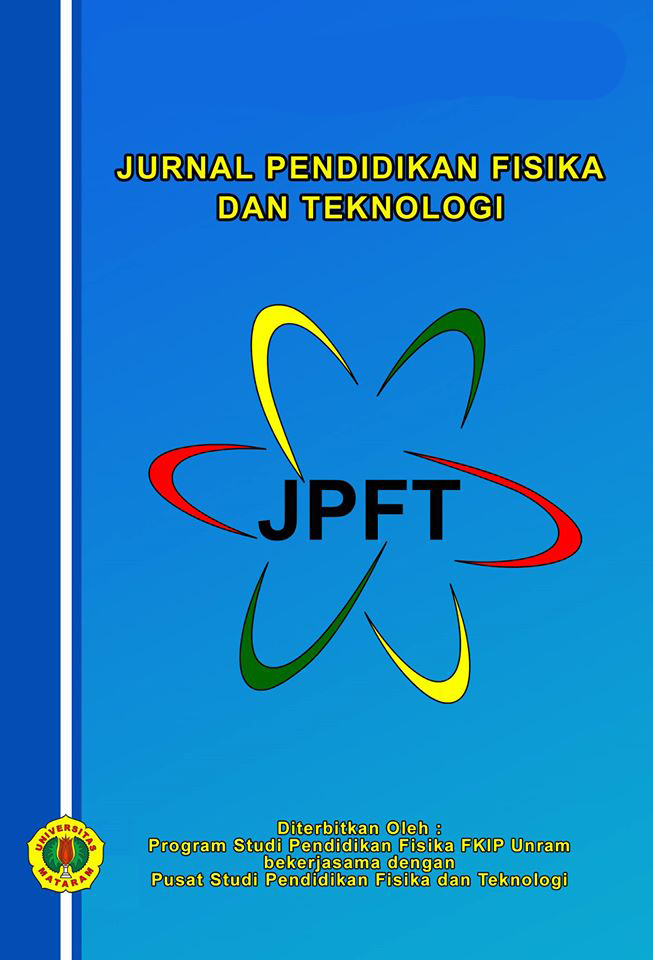Development of Android-Based Interactive Multimedia for Secondary School Physics Study
DOI:
10.29303/jpft.v9i1.4717Published:
2023-05-17Issue:
Vol. 9 No. 1 (2023): January - JuneKeywords:
Android Based , Interactive Multimedia, Concept Mastery, ElasticityArticles
Downloads
How to Cite
Downloads
Metrics
Abstract
This research aims to produce valid and practical learning products for physics education. The developed learning products consist of interactive multimedia based on Android, lesson plans (RPP), and test instruments for the topic of elasticity in physics. This study follows a Research and Development (R&D) approach, adapting the 4D model developed by Thiagarajan. The research stages include defining, designing, developing, and disseminating. The research subjects were 32 students in grade XI. Data collection techniques involved validation sheets, student response questionnaires, and pretest and posttest sheets for assessing conceptual understanding. The validation results indicate that the learning products fall under high validity. The average scores of expert and practitioner validators were 3.49 and 3.67 for interactive multimedia based on Android, 3.48 and 3.69 for the lesson plans, and 3.38 and 3.81 for the test instruments, respectively. The analysis of the response questionnaires showed that the products were convenient, with an average percentage of 82.27%. Therefore, the developed learning products are valid and highly practical for secondary school physics activities.
References
Alismail, H.A, & McGuire, P. (2015). 21st Century Standards and Curriculum Curent Research and Practice. Journal of Education and Practice. 6(6): 150-154.
Astuti, D. P., Nuraini, N. L. S., & Roebyanto, G. 2021. Pengembangan Multimedia Interaktif Berbasis Android dengan Model Problem Based Learning Muatan Matematika Materi Bangun Ruang Kelas V SD. Jurnal Pembelajaran, Bimbingan dan Pengelolaan Pendidikan. 1 (8): 653-659. DOI: https://doi.org/10.17977/um065v1i82021p653-659
Awwaliyah, R. (2018). Pendidikan Islam Dalam Sistem Pendidikan Nasional. Jurnal Ilmiah Didaktika, (19)(1), 34-49.
Daryanto. 2016. Media Pembelajaran. Yogyakarta: Gava Media.
Gunawan, G., Harjono, A., & Sutrio, S. (2015). Multimedia Interaktif Dalam Pembelajaran Konsep Listrik Bagi Calon Guru. Jurnal Pendidikan Fisika dan Teknologi. 1(1): 9-14. DOI: https://doi.org/10.29303/jpft.v1i1.230
Husein, S., Herayanti, L., & Gunawan. (2015). Pengaruh Penggunaan Multimedia Interaktif Terhadap Penguasaan Konsep dan Keterampilan Berpikir Kritis Siswa Pada Materi Suhu dan Kalor. Jurnal Pendidikan Fisika dan Teknologi. 1(3): 221-225. DOI: https://doi.org/10.29303/jpft.v1i3.262
Maulina, M., Andriyani, A.S., Amin, S., Nasrullah, R., Asdar, A., & Hamsiah, A. (2022). Students’ Perception in Learning English through Blended Learning. Journal of Education and Teaching (JET). 3(1): 50-68. DOI: https://doi.org/10.51454/jet.v3i1.138
Muzakkir, M.A., Pomalato, S.W.Dj., & Katili, M.R. (2022). Efektivitas Multimedia Interaktif Berbasis Smartphone untuk Pembelajaran Matematik. Jambura Journal of Mathematics Education. 3 (2): 81-92. DOI: https://doi.org/10.34312/jmathedu.v3i2.15605
Novitasari, D. (2016). Pengaruh Penggunaan Multimedia Interaktif Terhadap Kemampuan Pemahaman Konsep Matematis Siswa. Jurnal Pendidikan Matematika & Matematika. 2(2): 8-18. DOI: https://doi.org/10.24853/fbc.2.2.8-18
Nurindah, N., & Kasman, K. (2021). Implementasi Media Pembelajaran Berbasis Android Terhadap Hasil Belajar Bahasa Indonesia. Akademika, 10(01), 1–12. DOI: https://doi.org/10.34005/akademika.v10i01.1311
Nurjannah, E., Ayub, S., Doyan, A., & Sahidu, H. (2021). Pengembangan Perangkat Pembelajaran Model Inkuiri Terbimbing Berbantuan Media PhET untuk Meningkatkan Kemampuan Pemecahan Masalah dan Keterampilan Generik Sains Fisika Peserta Didik. Jurnal Pendidikan, Sains, Geologi, dan Geofisika. 2(1): 21-25. DOI: https://doi.org/10.29303/goescienceedu.v2i1.127
Nurmaya, Y., Susilawati, S. Zuhdi, M., & Hikmawati, H. (2021). Pengembangan Perangkat Pembelajaran Model Inkuiri Terbimbing Pada Materi Alat-Alat Optik untuk Meningkatkan Penguasaan Konsep Fisika. Jurnal Hasil Kajian, Inovasi, dan Aplikasi Pendidikan Fisika. 7 (1): 147-154. DOI: https://doi.org/10.31764/orbita.v7i1.3835
Pangestika, M. W., Suyanto, E., & Viyanti, V. (2013). Pengembangan Lembar Kerja Peserta didik Berbasis Keterampilan Proses Sains pada Kompetensi Dasar Menyelidiki Sifat-Sifat Zat Berdasarkan Wujudnya dan Penerapannya dalam Kehidupan Sehari-Hari. Jurnal Pembelajaran Fisika, 1(1), 55-65.
Pubian, Y. M., & Herpratiwi, H. (2022). Penggunaan Media Google Site Dalam Pembelajaran Untuk Meningkatkan Efektifitas Belajar Peserta Didik Sekolah Dasar. Akademika, 11(01), 163–172. DOI: https://doi.org/10.34005/akademika.v11i01.1693
Pusparisa, T. (2021). Daftar Negara Pengguna Smartphone Terbanyak, Indonesia Urutan Berapa. Diakses dari (https://databoks.katadata.co.id/datapublish/2021/07/01/daftar-negara-pengguna-smartphone-terbanyak-indonesia-urutan-berapa).
Tabrani, M. B., Rini, P. P., & Junedi, B. 2021. Pengembangan Multimedia Interaktif Berbasis Android pada Materi Kualitas Instrumen Evaluasi Pembelajaran Matematika. Jurnal Inovasi Teknologi Pendidikan. 8 (1): 163-172. DOI: https://doi.org/10.21831/jitp.v8i2.42943
Thiagarajan, S., Semmel, D. S. & Semmel, M. I. (1974). Intructional Development for Training Teachers of Exeptional Children. Minnesota: University of Minnesota.
Wibawanto, W. (2017). Desain dan Pengembangan Multimedia Pembelajaran Interaktif. Jawa Timur: Penerbit Cerdas Ulet Kreatif.
Wiyono, K., & Khamzawi, S. (2015). Pengembangan Multimedia Interaktif Berbasis Model Pembelajaran Problem Based Leaning Pada Mata Pelajaran Fisika Pokok Bahasan Fuida Dinamis Untuk SMA Kelas XI. Jurnal Inovasi Dan Pembelajaran Fisika. 2(1), 100–108.
Author Biographies
Rizki Yunita, Universitas Mataram
Gunawan Gunawan, Universitas Mataram
Ahmad Harjono, Universitas Mataram
Kosim Kosim, Universitas Mataram
License
Copyright (c) 2023 Rizki Yunita Rizki, Gunawan Gunawan, Ahmad Harjono, Kosim Kosim

This work is licensed under a Creative Commons Attribution-ShareAlike 4.0 International License.
Authors who publish with Jurnal Pendidikan Fisika dan Teknologi (JPFT) agree to the following terms:
- Authors retain copyright and grant the journal right of first publication with the work simultaneously licensed under a Creative Commons Attribution License 4.0 International License (CC-BY-SA License). This license allows authors to use all articles, data sets, graphics, and appendices in data mining applications, search engines, web sites, blogs, and other platforms by providing an appropriate reference. The journal allows the author(s) to hold the copyright without restrictions and will retain publishing rights without restrictions.
- Authors are able to enter into separate, additional contractual arrangements for the non-exclusive distribution of the journal's published version of the work (e.g., post it to an institutional repository or publish it in a book), with an acknowledgement of its initial publication in Jurnal Pendidikan Fisika dan Teknologi (JPFT).
- Authors are permitted and encouraged to post their work online (e.g., in institutional repositories or on their website) prior to and during the submission process, as it can lead to productive exchanges, as well as earlier and greater citation of published work (See The Effect of Open Access).











